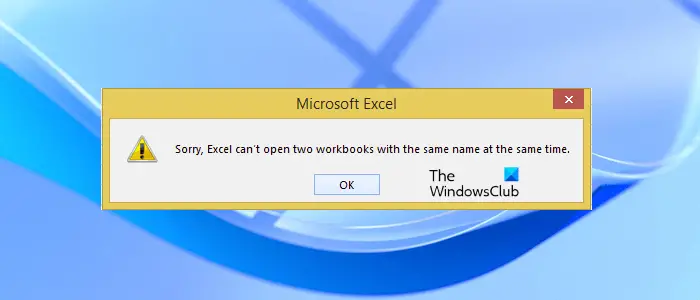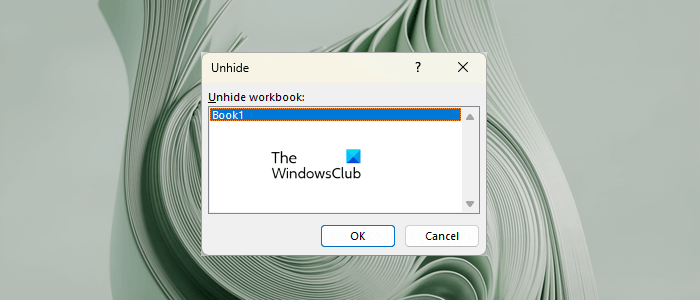If while opening an Excel file, you receive the “Sorry, Excel can’t open two workbooks with the same name at the same time” error message, the solutions provided in this article will help you. According to the users who experienced this problem, this error message occurs while opening new as well as existing Excel files. Whereas, some users encountered this issue while opening only the existing Excel files.

Sorry, Excel can’t open two workbooks with the same name at the same time
Use the following solutions to get rid of the “Sorry, Excel can’t open two workbooks with the same name at the same time” error message in Excel.
- Check for any hidden workbooks
- Rename the file
- Start a new instance of Microsoft Excel
- Open Excel in Safe Mode
- Check for duplicate Add-ins
- Move files from the XLSTART folder to another location
- Repair or reinstall Office
Let’s see all these fixes in detail.
1] Check for any hidden workbooks

In Excel, you can hide the opened workbooks. This can be done as follows:
- Open Microsoft Excel.
- Create a new file or open the existing one.
- Go to the View tab.
- Click Hide under the Window group.
To unhide the workbook(s), click Unhide in the View tab. If you can create a new workbook in Excel but can’t open the existing workbook, there is a possibility that the workbook is opened but hidden. However, if you open the file that is hidden in Excel, you will see an error message different than that in question. But you can still try this fix and see if it helps.
Create a new workbook in Excel and then go to the View tab. Now, see if the Unhide option is clickable or not. If yes, click on it and select the file(s) to unhide.
2] Rename the file
The meaning of the error message is self-explanatory. Excel is considering that a file is already opened and it has the same name as the file you are trying to open. Therefore, change the name of the file you are opening. This should help.
3] Start a new instance of Microsoft Excel
Run a new instance of Microsoft Excel and see if the error message appears this time or not. Follow the steps provided below:
- Right-click on the Excel icon on your Taskbar. If Excel is not available on your Taskbar, you have to pin it there.
- Press and hold the left Alt key.
- Click Excel 2016. In your case, the version number of Excel may be different.
- You will receive a prompt asking you to open a new instance of Excel, click Yes.
- Release the Alt key when the Excel opens up.
Now, create a new blank workbook and see what happens.
4] Open Excel in Safe Mode
In Microsoft Office, sometimes, problems occur due to conflicting add-ins. This might be the case with you, as the same thing has been reported by a lot of users who encountered this error. Open Excel in Safe Mode and see what happens.
If the issue does not appear in the Safe Mode, you need to find out the problematic add-in. To do so, disable add-ins one by one and see if the problem appears or not. You have to disable both Excel and COM add-ins.
To disable add-ins, you need to create a new workbook or the existing one in Excel. If you can create a new workbook, create it. If not, do this. Go to your Desktop and right-click in the empty space. Now, go to “New > Microsoft Excel Worksheet.” Now, open this new worksheet and follow the steps provided below:
- Go to File > Options.
- Select Add-ins from the left side.
- Select Excel Add-ins from the drop-down and click Go.
- Uncheck the selected add-ins one by one and click OK.
- See if the problem persists.
Follow the same steps to find out the problematic COM Add-in. This time you have to disable COM Add-ins. Hence, select the COM Add-ins in the drop-down.
5] Check for duplicate Add-ins
You should also check whether two add-ins with the same name are installed in Excel or not. If yes, these add-ins will have different formats, say .dll and .xlsm. To check this, go to “File > Options > Add-Ins” in Excel. You will see a list of all installed add-ins on the right side. See if two add-ins have the same name or not. If you find duplicate add-ins with the same name, disable any one of them. This will fix the issue.
6] Move files from the XLSTART folder to another location
In Excel, you can create add-ins by using Visual Basic Editor. After that, you can save it at any location on your system but you have to select the file type as Excel Add-in. The saved Excel Add-in file has the .xlam extension.
To make an Excel file open automatically when you open Excel, you can place it in the XLSTART folder. This folder is usually used to store Excel templates. But you can also use it to store your Excel files. If you want your created Excel add-ins to run automatically when you launch Excel, you can place them here.
If you have created an Excel Add-in file and it has the default name, say Book 1; and you have placed it in the XLSTART folder, it will start running automatically when you launch Excel. This is the reason why you are getting this error message every time you create a new workbook in Excel. Move that file to another location or change its name.
The default location of the XLSTART folder is:
%appdata%\Microsoft\Excel\XLSTART
Open the Run command box and type the above command in it. After that, click OK. Windows will open the XLSTART folder automatically.
7] Repair or reinstall Office
If none of the above solutions fixed your issue, repair Microsoft Office. Running an online repair will help. If this does not help, uninstall and reinstall Office. But before you do this, make sure that you have your Office activation key.
I hope this helps.
Why can’t I open two Excel workbooks at the same time?
If the two Excel workbooks have the same name, you cannot open them at the same time. For this, either close one of them and then open the other or change the name of one of them.
How do I open two Excel workbooks at the same time?
You can open multiple instances of Excel as well as multiple workbooks. To do so, press the Ctrl + O keys and select the Excel file you want to open. Alternatively, go to “File > Open.” Or, you can open workbooks directly by double-clicking on them.
Read next: Excel found a problem with one or more formula references in this worksheet.